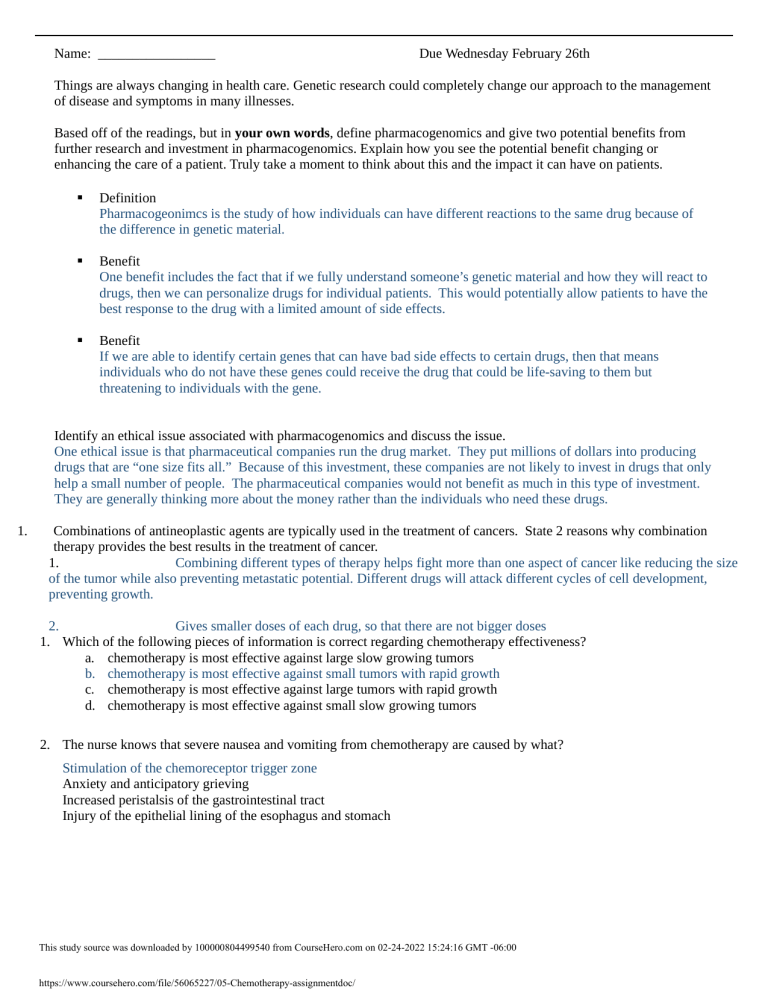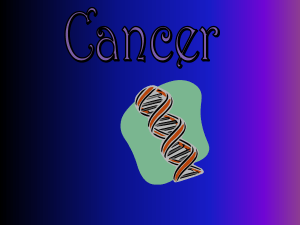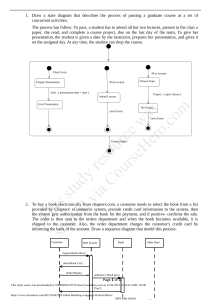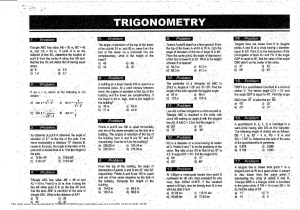
Name: _________________ Due Wednesday February 26th Things are always changing in health care. Genetic research could completely change our approach to the management of disease and symptoms in many illnesses. Based off of the readings, but in your own words, define pharmacogenomics and give two potential benefits from further research and investment in pharmacogenomics. Explain how you see the potential benefit changing or enhancing the care of a patient. Truly take a moment to think about this and the impact it can have on patients. Definition Pharmacogeonimcs is the study of how individuals can have different reactions to the same drug because of the difference in genetic material. Benefit One benefit includes the fact that if we fully understand someone’s genetic material and how they will react to drugs, then we can personalize drugs for individual patients. This would potentially allow patients to have the best response to the drug with a limited amount of side effects. Benefit If we are able to identify certain genes that can have bad side effects to certain drugs, then that means individuals who do not have these genes could receive the drug that could be life-saving to them but threatening to individuals with the gene. Identify an ethical issue associated with pharmacogenomics and discuss the issue. One ethical issue is that pharmaceutical companies run the drug market. They put millions of dollars into producing drugs that are “one size fits all.” Because of this investment, these companies are not likely to invest in drugs that only help a small number of people. The pharmaceutical companies would not benefit as much in this type of investment. They are generally thinking more about the money rather than the individuals who need these drugs. 1. Combinations of antineoplastic agents are typically used in the treatment of cancers. State 2 reasons why combination therapy provides the best results in the treatment of cancer. 1. Combining different types of therapy helps fight more than one aspect of cancer like reducing the size of the tumor while also preventing metastatic potential. Different drugs will attack different cycles of cell development, preventing growth. 2. Gives smaller doses of each drug, so that there are not bigger doses 1. Which of the following pieces of information is correct regarding chemotherapy effectiveness? a. chemotherapy is most effective against large slow growing tumors b. chemotherapy is most effective against small tumors with rapid growth c. chemotherapy is most effective against large tumors with rapid growth d. chemotherapy is most effective against small slow growing tumors 2. The nurse knows that severe nausea and vomiting from chemotherapy are caused by what? Stimulation of the chemoreceptor trigger zone Anxiety and anticipatory grieving Increased peristalsis of the gastrointestinal tract Injury of the epithelial lining of the esophagus and stomach This study source was downloaded by 100000804499540 from CourseHero.com on 02-24-2022 15:24:16 GMT -06:00 https://www.coursehero.com/file/56065227/05-Chemotherapy-assignmentdoc/ 3. A patient receiving chemotherapy develops hyperuricemia. A nursing priority addresses the effect of the uric acid crystals on: a. b. c. d. blood joints kidneys liver 4. A patient with brain cancer asks the nurse why the chemotherapy is going into a catheter in her back instead of into a vein. The nurse’s response should be that this route a. b. c. d. allows higher doses of chemotherapy to be used. allows the drug to get to the tumor cells. prevents many side effects throughout the body. prevents mutation of the cancer cells. 5. For a cancer patient who is receiving chemotherapy, which food would be least likely to cause an infection if the patient has neutropenia? a. b. c. d. avocado organic broccoli ham bought at a deli counter yogurt 6. A patient receiving chemotherapy develops hyperuricemia. A nursing priority addresses the effect of the uric acid crystals on which body part? a. b. c. d. blood joints kidneys liver 7. A patient with non-Hodgkin’s lymphoma is prescribed cyclophosphamide [Cytoxan]. It is most important for the nurse to teach the patient (all of these are correct information to teach the patient) : a. b. c. d. You will likely experience diarrhea while on this medication. Alopecia is a potential side effect of this medication. Dizziness is a potential side effect Report unexplained bruising 8. One of the nurse’s roles in the administration of antineoplastic agents is to monitor for the inevitable side effects of chemotherapy. The primary reason for drawing a complete blood count (CBC) is to monitor for: a. b. c. d. early detection of electrolyte imbalance. thrombocytopenia and leukopenia. inflammatory responses. early signs of anemia. 9. Your patient receiving chemotherapy is experiencing a low WBC count. Which nursing action is most appropriate? a. assess for change in temperature b. assess for evidence of petechaie c. assess for increase in fatigue d. assess for increase in bleeding This study source was downloaded by 100000804499540 from CourseHero.com on 02-24-2022 15:24:16 GMT -06:00 https://www.coursehero.com/file/56065227/05-Chemotherapy-assignmentdoc/ 10. The timing and dose of antineoplastic medications can be affected by all of the following EXCEPT: a. b. c. d. hemorrhage. myelosuppression. hepatotoxicity. severe nausea/vomiting. 11. A patient receiving chemotherapy for oropharyngeal carcinoma has raw and swollen oral mucosa. He has painful ulcerations over his bucca and tongue and finds it difficult to chew and swallow. An appropriate intervention for the nurse to teach the patient is to: (select all that apply) a. b. c. d. e. maintain a high protein, high calorie liquid diet until the acute ulcerations subside. have the patient sit at a 90-degree angle for all meals. rinse his mouth after each meal and at bedtime with a solution of salt and water. drink at least 2 liters a day of ice cold water to assure adequate hydration. drink a cup of hot tea after each meal 12. What drug might be used with a low WBC? Colony-stimulating drugs, such as filgrastim 13. A patient receiving chemotherapy is anemic. Which medication does the nurse anticipate administering to this patient? a. b. c. d. Filgrastim Pegfilgrastim Neumega Erythropoietin 14. Which statement about alkylating agents does the nurse identify as true? a. b. c. d. Alkylating agents are toxic to tissues that have a low growth fraction. Methotrexate is an alkylating agent. None of the alkylating agents are vesicants. Development of resistance to alkylating agents is common. 15. A patient is taking tamoxifen [Nolvadex] for treatment of breast cancer with metastatic bone cancer. It is most important for the nurse to assess the patient for the development of what? a. b. c. d. Hyperphosphatemia Hypercalcemia Hypokalemia Hyponatremia 16. The prescriber of a potentially cardiotoxic drug asks the nurse “what is the patient’s weight?”. What information is the prescriber seeking a. actual weight in kilograms b. change in weight compared to yesterday c. body mass index 17. Filgrastim is ordered as a once a day medication based on weight. The usual dose is 5mcg/kg/day. The patient weighs 132 pounds. What does should you anticipate seeing in the order? 300 mcg This study source was downloaded by 100000804499540 from CourseHero.com on 02-24-2022 15:24:16 GMT -06:00 https://www.coursehero.com/file/56065227/05-Chemotherapy-assignmentdoc/ Powered by TCPDF (www.tcpdf.org)





